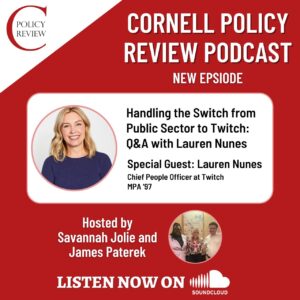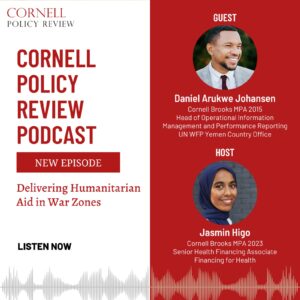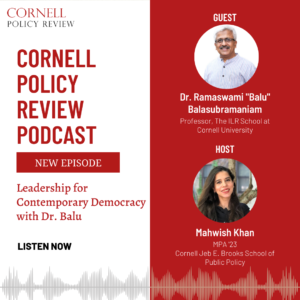
Source: Unsplash, Nabeel Syed
Written by Franco Botta
Edited by Charlie Mann, Alejandra Plaza, and Tiffany Agard
A Congested Public Good
If you are constantly making your commute music playlist longer to withstand traffic, you are not alone. Traffic congestion in the U.S. has been exacerbated by the country’s growing dependency on automobiles. The average person in the United States spends approximately 54 hours stuck in traffic, and drivers in megacities like Los Angeles spend more than 119 hours every year navigating congested roads.1 A longer playlist is only a temporary fix, especially when the 2019 Urban Mobility Report published by the Texas A&M Transportation Institute predicts that traffic congestion rates will rise by approximately 15% by 2025.2 However, post-pandemic workflow changes and more flexibility to work from home may challenge this.
These congested roads are a non-exclusive public good and accessible to anyone with a car or other form of mobile transportation. This can create an occupancy problem in which drivers utilize the roads regardless of available space. For example, a community park is open to the public and does not specify or enforce an explicit capacity; However, if the entire community visits simultaneously, this would exceed the congestion threshold, and the park would become unenjoyable because it is too crowded. The same phenomenon occurs during peak commuting hours and creates negative externalities for other drivers in the form of delays, a decrease in the overall quality of life, increased cost of traveling, environmental pollutants, and traffic accidents.3
Adam Smith’s Invisible Hand theory illustrates how the natural forces of the market guide the supply and demand of a good or service to equilibrium. Smith argues that markets should be allowed to operate naturally in order to achieve stability. Policies that advocate for vouchers and credits instead of a distortion or elimination of prices support the operational functioning of the markets.5 Extensive traffic congestion suggests that natural market forces are constrained by the lack of pricing of this public good, misaligning the value and cost of its use. Therefore, the solution to road congestion should adhere to the economic principles that encourage equilibrium and efficiency by pricing services and using non-distortionary strategies that naturally align with the market forces to achieve equity.
Using Market Forces to Reduce Congestion:
Peter Cramton, R. Richard Geddes, and Axel Ockenfels have written extensively around surface transportation policy and economies over the past few decades. Over the past few years, they have proposed and advocated for a holistic solution that seeks to address the issue of traffic congestion. The Cramton, Geddes, and Ockenfels model claims that real-time road pricing is the only feasible approach to mitigate the issue of traffic congestion in its entirety.6 This automatic process would require the use of an Independent System Operator (ISO), a locational device that identifies and prices the roads a driver uses based on demand.6 Using a synchronous kinematic device to price road usage in real-time allows the market to act naturally and achieve the optimal amount of road usage by eliminating traffic congestion. Reducing travel times also mitigates detrimental environmental externalities by reducing the overall pollution emitted by cars.6
This system is unique in that it allows drivers to pay based on how much they value the use of the road. Peak hours would be the most expensive and those who sufficiently value driving at that time would be willing to pay the elevated price. On the other hand, people who do not value it as much would rather utilize the road at different times based on their preferences. This approach would not reduce the number of vehicles using a road, it would actually increase them by ensuring the road is in constant flow.7 Despite being private services, the concept is employed in the aeronautical and hospitality industry in which prices are adjusted based on the real-time demand for the services.6 This is a non-distortionary approach that focuses on pricing the service based on its current demand and limited capacity. Popular seasons like Christmas have a higher demand than usual. This is the reason why airplane tickets and hospitality services are more expensive than usual. The real-time pricing mechanism ensures that the aeronautical and hospitality industries do not run out of space when demand is higher and operate inefficiently. Instead, the natural market forces allow them to operate efficiently while allowing those who value the service the most to use it. Road-usage can become efficient and bearable again by letting market forces determine its price.
Road-Time Pricing Abroad
This type of policy solution has been implemented with varying degrees of success in the international metropolises of the world. In Stockholm, there is a real-time congestion control system in which drivers pay for using the road in the city center. After a successful six-month trial in 2006, the citizens of Stockholm voted for the full implementation of a road pricing mechanism that reduces congestion and pollution while improving travel times.8 After its full implementation, congestion decreased by approximately 20% and reduced travel time in the city by 30 to 50%.9 Similarly, Milan has had a road pricing mechanism since 2008 that operates with the objective of decreasing overall pollution levels and traffic congestion citywide.10 The policy restricts certain cars with high emissions rates from entering the city center while charging drivers with acceptable engine classes for using the road on weekdays. As a result, traffic congestion rates reduced by 21% and emission rates by 14-23%.10 In Singapore, every vehicle is required to pay a user fee tax that is calculated based on the capacity, age, and fuel consumption of the car. Since 1998, the city has used an Electronic Road Pricing system (ERP) in which the drivers are charged in real-time based on their location and vehicle type.11 After the implementation of this traffic control system, traffic congestion decreased by approximately 24%.11 Despite the different approaches to mitigate congestion, the method of synchronously pricing users is a common reason why they were able to reduce traffic congestion and automobile emission rates.
Inspecting Blindspots and Flat Tires
Fairness
Critics of the Cramton, Geddes, and Ockenfels model do not believe that it is fair, can protect drivers’ privacy, and is supported by the general public. First, many criticize real-time road pricing by arguing that it would only benefit drivers who have the resources to pay for the road. However, charging for road use would result in a significant amount of revenue that could be used to provide vouchers and subsidies to those that cannot afford to pay the transportation fee. The revenue collected could also be invested in areas that benefit the public such as public transportation systems and road maintenance.12 Second, long commute times in traffic affect everyone on the road by occupying a significant amount of time every day that could be used to work or rest. Addressing traffic congestion can make the driving experience more enjoyable, affordable, and sustainable for users regardless of their location and budget.
Privacy Concerns
As technology advances, concerns over privacy become more frequent in the policy arena. For example, the use of an ISO for real-time road pricing that has access to the location of the car and the roads used at all times has raised many privacy concerns. Fortunately, however, current technology can allow the ISO to be cryptographically secure so no human has access to the drivers’ location and transportation history.6 This encrypted connection is commonly used on smartphone apps that need to know the location of the user in order to provide the service. Despite encryption and the frequent use of apps that require access to personal information, privacy concerns remain one of the main reasons why the public is skeptical about the real-time road pricing approach.
Lack of Public Support
Public support is pivotal when implementing new ideas and initiatives to positively change the status quo. In this scenario, the concept of real-time road pricing lacks support as many believe it is not feasible or that the benefits do not outweigh the downsides. However, the policies have often gained widespread public support after their initial implementation. For example, before user fees were implemented in 2006 less than 40% of the voters in Stockholm supported the initiative as they were skeptical about its effectiveness. However, in 2011, the real-time road pricing policy received an approval rate of 70%.8 Similarly, 80% of the citizens of Milan voted to extend the areas in which the real-time road pricing applied after heavily opposing the initiative at first.12 Therefore, there is an initial sense of mistrust and skepticism at the public level when it comes to road pricing that makes it difficult for policymakers to implement or even suggest this approach.
Despite its critiques, real-time road pricing has proven to be a feasible solution that mitigates the problem of traffic congestion by allowing market forces to act naturally based on the demand for the road and respective utility for the drivers. Roads should be priced based on their synchronous demand like the aeronautical and hospitality industry to prevent the public goods problem from overcrowding roads. The Cramton, Geddes, and Ockenfels model provides an economically guided approach in which drivers pay based on how much they value the service which allows the roads to be in continuous flow. Optimizing the use of roads also produces positive externalities like decreased pollution levels and improved travel times. Despite numerous concerns in the areas of privacy, equity, and public skepticism, numerous countries have successfully implemented this policy initiative and reduced both traffic congestion and pollution as a result. Therefore, implementing non-distortionary strategies that allow the market forces to act naturally as the model suggests can be an efficient way for policymakers to alleviate traffic congestion in an equitable manner.
References
- Liu, Jennifer. “Commuters in This City Spend 119 Hours a Year Stuck in Traffic.” CNBC. CNBC, September 4, 2019. https://www.cnbc.com/2019/09/04/commuters-in-this-city-spend-119-hours-a-year-stuck-in-traffic.html.
- Schrank, David, Bill Eisele, and Tim Lomax. “2019 URBAN MOBILITY REPORT.” Urban Mobility Information, 2019. https://mobility.tamu.edu/umr/.
- Falcocchio, John C., and Herbert S Levinson. “The Costs and Other Consequences of Traffic Congestion.” Essay. In ROAD TRAFFIC CONGESTION: a Concise Guide, 159–82. Place of publication not identified: SPRINGER INTERNATIONAL PU, 2015.
- Perloff, Jeffrey M. Microeconomics. 8th ed. New York, NY: Pearson, 2018.
- United States. President (2000-2005 : Bush). Economic Report of the President: Transmitted to the Congress; Together with the Annual Report of the Council of Economic Advisors. Washington, D.C. :U.S. Govt. Printing Office, 197074.
- Cramton, Peter, R. Richard Geddes, and Axel Ockenfels. “Using technology to eliminate traffic congestion.” Journal of Institutional and Theoretical Economics 175, no. 1 (2019): 126-39.
- Federal Highway Administration. “Congestion Pricing – A Primer: Overview.” US Department of Transportation, 2008. https://ops.fhwa.dot.gov/publications/fhwahop08039/fhwahop08039.pdf.
- Meyer, David. “Congestion Pricing Was Unpopular in Stockholm – Until People Saw It in Action.” Streetsblog New York City, November 29, 2017. https://nyc.streetsblog.org/2017/11/28/congestion-pricing-was-unpopular-in-stockholm-until-people-saw-it-in-action/.
- Eliasson, Jonas, Lars Hultkrantz, Lena Nerhagen, and Lena Smidfelt Rosqvist. “The Stockholm congestion–charging trial 2006: Overview of effects.” Transportation Research Part A: Policy and Practice 43, no. 3 (2009): 240-250.
- Cramton, Peter, R Richard Geddes, and Axel Ockenfels. “Markets for Transport Eliminating Congestion through Scheduling, Routing, and Real-Time Pricing.” http://www.cramton.umd.edu/, June 7, 2018. http://www.cramton.umd.edu/papers2015-2019/cramton-geddes-ockenfels-markets-for-road-use-slides.pdf.
- Federal Highway Administration. “Lessons Learned From International Experience in Congestion Pricing 2.0 Summary Of Selected Projects And Findings.” Lessons Learned From International Experience in Congestion Pricing, 2017. https://ops.fhwa.dot.gov/publications/fhwahop08047/02summ.htm.
- Cramton, Peter, R Richard Geddes, and Axel Ockenfels. “Set Road Charges in Realtime to Ease Traffic.” http://www.cramton.umd.edu/, 2018. http://www.cramton.umd.edu/papers2015-2019/cramton-geddes-ockenfels-dynamic-road-pricing.pdf.





